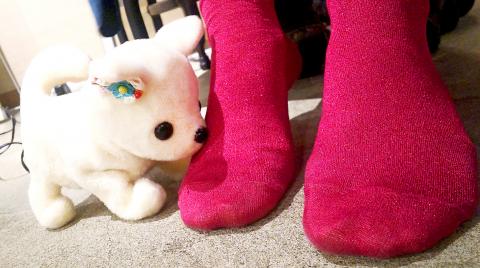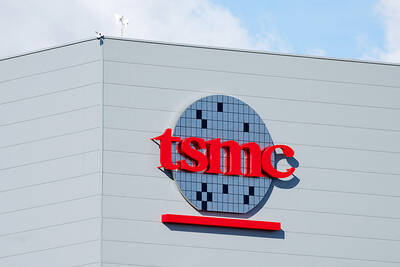Do your feet smell bad? Just a little or absolutely awful? If you do not dare to ask a friend, one Japanese start-up might have the answer with a robot dog that will sniff your feet and give you a pitilessly honest verdict — even fainting if the stink is especially strong.
Malodorous feet can be socially awkward in Japan where shoes are removed at the entrance to every home.
Hana-chan — a play on the Japanese word for nose and a common girl’s nickname — is a helpful little robot mutt who will bark if she detects moderately stinky toes, but will keel over if the pong is particularly pungent.

Photo: AFP / Next Technology
The 15cm dog, equipped with an odor detection sensor for a nose, also sprays air freshener to resolve the situation if the aroma is unbearable.
Manufacturer Next Technology created the robot in response to a request from a man who was desperate to know if he had a problem.
“He told us his daughter had said his feet were smelly ... but he didn’t want to know how bad the odor was because he would feel hurt,” employee Kimika Tsuji said. “That’s why we developed this cute robot.”
Tsuji said smells are becoming more of an issue in Japan, a place where subjecting others to your honking body can even be considered harassment.
In July, Konica Minolta, a Japanese tech company, began pre-sales of a pocket-sized device that allows people to self-test three categories of smell on a scale from 0 to 100.
Next Technology plans to start selling the robot dog early next year, with a price tag of more than ¥100,000 (US$931).

Taiwan Semiconductor Manufacturing Co (TSMC, 台積電) secured a record 70.2 percent share of the global foundry business in the second quarter, up from 67.6 percent the previous quarter, and continued widening its lead over second-placed Samsung Electronics Co, TrendForce Corp (集邦科技) said on Monday. TSMC posted US$30.24 billion in sales in the April-to-June period, up 18.5 percent from the previous quarter, driven by major smartphone customers entering their ramp-up cycle and robust demand for artificial intelligence chips, laptops and PCs, which boosted wafer shipments and average selling prices, TrendForce said in a report. Samsung’s sales also grew in the second quarter, up

LIMITED IMPACT: Investor confidence was likely sustained by its relatively small exposure to the Chinese market, as only less advanced chips are made in Nanjing Taiwan Semiconductor Manufacturing Co (TSMC, 台積電) saw its stock price close steady yesterday in a sign that the loss of the validated end user (VEU) status for its Nanjing, China, fab should have a mild impact on the world’s biggest contract chipmaker financially and technologically. Media reports about the waiver loss sent TSMC down 1.29 percent during the early trading session yesterday, but the stock soon regained strength and ended at NT$1,160, unchanged from Tuesday. Investors’ confidence in TSMC was likely built on its relatively small exposure to the Chinese market, as Chinese customers contributed about 9 percent to TSMC’s revenue last

With this year’s Semicon Taiwan trade show set to kick off on Wednesday, market attention has turned to the mass production of advanced packaging technologies and capacity expansion in Taiwan and the US. With traditional scaling reaching physical limits, heterogeneous integration and packaging technologies have emerged as key solutions. Surging demand for artificial intelligence (AI), high-performance computing (HPC) and high-bandwidth memory (HBM) chips has put technologies such as chip-on-wafer-on-substrate (CoWoS), integrated fan-out (InFO), system on integrated chips (SoIC), 3D IC and fan-out panel-level packaging (FOPLP) at the center of semiconductor innovation, making them a major focus at this year’s trade show, according

DEBUT: The trade show is to feature 17 national pavilions, a new high for the event, including from Canada, Costa Rica, Lithuania, Sweden and Vietnam for the first time The Semicon Taiwan trade show, which opens on Wednesday, is expected to see a new high in the number of exhibitors and visitors from around the world, said its organizer, SEMI, which has described the annual event as the “Olympics of the semiconductor industry.” SEMI, which represents companies in the electronics manufacturing and design supply chain, and touts the annual exhibition as the most influential semiconductor trade show in the world, said more than 1,200 enterprises from 56 countries are to showcase their innovations across more than 4,100 booths, and that the event could attract 100,000 visitors. This year’s event features 17